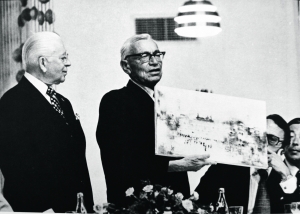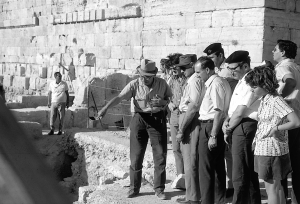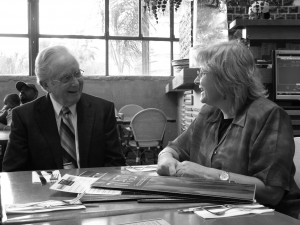After the 1967 war, areas available for archaeological exploration greatly expanded with the addition of Judea and Samaria to Israel’s territory. One of the first excavations to commence was in the area encompassing the entire length of the southern wall of the Temple Mount, the area of the current excavations on the Ophel. These excavations were conducted by Prof. Benjamin Mazar, director of the Israel Exploration Society and former president of Hebrew University.
When Herbert W. Armstrong, founder of a liberal arts college located in Pasadena, Calif., heard of these new and exciting excavations, he visited Professor Mazar’s excavation. After seeing the excavations in full swing, Mr. Armstrong knew he wanted to be a part of such an important excavation. Immediately, he looked into using Ambassador College to provide funding to the excavation and volunteer labor during the summer months.
Soon afterward, Professor Mazar and Professor Aviram, the current head of the Israel Exploration Society, accepted Mr. Armstrong’s invitation to visit the Ambassador College students in California. By now, the leaders of the excavation and Ambassador had developed mutual trust and a friendship that would continue for decades to come. Though the archaeologists had turned down three other major American universities seeking involvement in their project, they now offered Ambassador College a 50/50 joint participation.
The next year, over 70 Ambassador students spent their summer excavating the Ophel with their Israeli counterparts. The “big dig,” as it became known, would continue for a decade, and hundreds of Ambassador students would have the opportunity to touch those ancient stones.
In addition to sending over what were praised as the excavation’s most enthusiastic laborers, Ambassador College shouldered half of the cost of excavations alongside Hebrew University from 1968 until the conclusion of the dig in 1976.
After years of research and labor, the big dig yielded artifacts dating back to the First Temple period in the seventh and eighth centuries B.C.—during the time of the temple originally built by Israel’s King Solomon.
During Benjamin Mazar’s excavations in the shadow of the Temple Mount, a young girl frequented the dig site, rubbing elbows with archaeologists and spending time with the Ambassador students and taking a keen interest in the work. Her name was Eilat.
In 1986, digging again commenced on the Temple Mount. This time, it was Eilat Mazar, the professor’s granddaughter, who was heading the project. The younger Mazar focused on the First Temple period at the eastern part of the site, and she continued in the spirit of her grandfather’s work throughout the 1990s.
Meanwhile, back in the United States, Mr. Armstrong had died. The leadership that took over Ambassador College discontinued with Mr. Armstrong’s mission and soon the college was no longer in operation and participation in Archaeological digs in Israel discontinued.
Mr. Gerald Flurry, a former student of Ambassador College, decided that the mission and vision of Mr. Armstrong had to continue. He eventually opened a small liberal arts college based in Edmond, Okla. in 2001. Mr. Flurry intended the college, which he named Herbert W. Armstrong College, to fulfill the same philanthropic and service orientated goals that Mr. Armstrong strived for with Ambassador.
Moving forward to August 2005, while digging the northern part of the ancient city of David, Dr. Eilat Mazar announced that she and her team had made a remarkable discovery in East Jerusalem: the remains of a large public building that dates to the 10th century B.C. Mazar believed that the evidence indicated this structure was none other than the palace of King David.
The following year, Herbert W. Armstrong College offered its support to Dr. Mazar’s work, sending a handful of students to assist with the continuing excavations.
Dr. Mazar still remembered the close relationship between her grandfather and Mr. Armstrong. “Without the support of Mr. Armstrong and the Ambassadors, the Temple Mount Excavations would have never become, as it did, the most important and largest excavations in Israel at that time,” she said. Dr. Mazar easily recognized the roots of Herbert W. Armstrong college, stating she was “excited to have the Ambassadors back with us.”
Since that time, Herbert W. Armstrong College has participated in several phases of Dr. Mazar’s excavations in Jerusalem, helping to make a string of remarkable discoveries.
In addition to the remains of what appears to be King David’s palace, Dr. Mazar and her team discovered that the Stepped Stone Structure in the City of David actually connects with the palace above, proving that they were built at the same time.
Later in 2007, excavating a tower adjacent to the palace, Dr. Eilat Mazar discovered that the fortification long thought to belong to the time of Hasmoneans was actually constructed during the time of the Biblical Nehemiah.
In the last week of the year, the team also found a bulla (seal impression) of Gedaliah the son of Pashur, one of Jeremiah’s accusers mentioned in Jeremiah 38:1.
In 2008, the team discovered a water tunnel more than 150 feet long that might have been the conduit King David’s forces used to conquer the city in the 10th century. Dr. Mazar called the excavation of the tunnel almost entirely an “Armstrong College enterprise.”
In late 2009 and early 2010, Herbert W. Armstrong College again was involved in Mazar’s excavations and helped unearth walls in what is believed to be a royal complex built by King Solomon. The city wall, located in the Ophel, is estimated to be more than 200 feet long and stands almost 20 feet high.
In 2012, Mazar resumed excavations on King Solomon’s complex at the Ophel and Herbert W. Armstrong College students returned to Jerusalem. In its largest contribution yet, over 20 representatives from the college assisted with the excavation. During this phase, the college established the Key to David’s City website to assist Dr. Mazar in publicizing her excavations in real time. Dr. Mazar continued the second phase in the summer of 2013, and was once again furnished with over a dozen Armstrong College student and alumni volunteers.
From January 2012 to October 2015 an archaeological exhibit was featured on the campus of Herbert W. Armstrong College in Edmond, Okla. with ancient artifacts from the First Temple Period found in all these excavations. Most notable were the two Hebrew bullae of Gedaliah and Jehucal found in the writings of the prophet Jeremiah, discovered during the excavation of the Palace of David.



